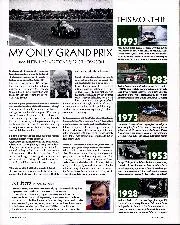
My hero
By Markku Alen "For me as a young man, before I even began rallying, I was inspired by the top three 'Flying Finns' — Hannu Mikkola, Timo Makinen and Pauli Toivonen. I…

At the time of writing there have been two grands prix, both of which went off without incident in the best possible sense. Because you can be sure that had there been even the sniff of a health emergency in Austria, the sport would have been branded irresponsible and dangerous and greedy for pressing ahead with a season that just a few weeks ago was in serious doubt.
That may still come to pass as the F1 charabanc moves through Europe over the coming weeks. But for now we must be thankful that we have some racing and the measures that the sport has put in place appear to be working.
Those measures include closed-door racing and, while it is a shame that fans can’t get to see the sport they love first hand, for the vast majority of those who watch grands prix on television the absence of a crowd is barely noticeable. In fact, F1 is probably one of the least affected sports when it comes to so-called stadium atmosphere. We have no need for the fake crowd roars which are being piped over football matches, or indeed the artificial “Lords murmur” that was played over the first test between England and West Indies.
The drama for us comes from the action on track combined with the stopwatch and noise of the engines; there is no need for an aural prompt of oohs and aahs from non-existent crowds. In fact, and at the risk of sounding curmudgeonly, the best thing about the lack of crowds is that TV producers do not feel the need to cut away to images of celebrities spotted within them or walking through the pit-lane.
The safeguards that have been put in place extend far further than just the lack of crowds, however. Mark Hughes, Motor Sport’s grand prix editor, is one of the few journalists to be admitted to the races which are operating under strict COVID protocols. He reports the following, which gives a flavour of what everyone involved in the races is experiencing. “As one of 22 journalists in a media centre built for 250, it was easy to keep socially distanced. But we had to remain in that bubble. There was no access to the paddock, nor track-side, for that would be to mix with people outside your bubble. Even away from the track, it was not permitted to socialise with those outside your group. So as a media representative I could not meet for a meal or a drink with, say, someone from the broadcaster group or a team member. If you are observed breaking that rule, you will be evicted from the event.” His full report from Austria is on page 24.
Although on the face of it the restrictions seem draconian, the reality is that in many ways F1 was the perfect sport to overcome the problem of putting on an event by overcoming a seemingly intractable problem (in this case, gathering a large number of people from different countries in close proximity to one another without sparking an outbreak of a highly contagious virus).
That’s because F1 makes its living from solving seemingly intractable problems. It is a precise sport where past actions are examined and outcomes measured. James Vowles, the Mercedes chief strategist, was quoted in a newspaper this month talking about F1’s “fail fast” culture. “Engineering is not just about what we know, but finding out what we don’t know, for with a complex problem there is a lot that even experts don’t know,” said Vowles. “That is why you challenge your assumptions quickly, figure out where your ideas are wrong, so you can improve them.”
It is a culture that has served the sport well on track and is now serving it well away from the track, too.
It is not only top-level motor racing that is re-emerging from enforced hibernation. The historic scene and grassroots events are also lining up on grids up and down the country – as Simon Arron reports from Cadwell Park in his feature on page 125 (we are grateful to MSUK and Jonathan Palmer of MSV for allowing us access).
And news also reaches us of an all-new Goodwood event to be held in October, which will go some way to rescuing summer. As the Duke of Richmond explains on page 114, Speedweek will be like the Members’ Meeting, the Revival and the Festival of Speed rolled into one. We can hardly wait.